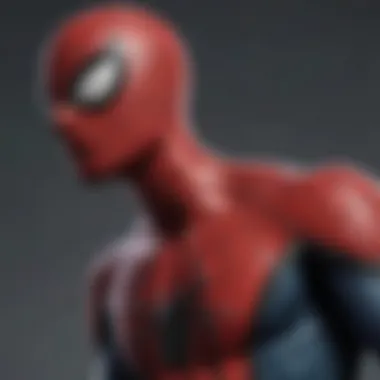Exploring Depths of the Third Spider-Man Movie


Intro
The third Spider-Man movie marked a turning point in the Spider-Man saga, capturing the imagination of audiences across the globe. For many, it signifies not only a continuation but a maturation of its character arcs and themes. This analysis intends to breakdown the intricate mixture of storytelling and performance in the film, offering a richer perception of its narratives. While the action captivated viewers, it was the characters and their development that left a significant impact. Understanding the character of Spider-Man in this movie is crucial to fully appreciate the work.
Spider-Man Character Analysis
Background
To comprehend the third Spider-Man film, one must delve into the character’s history. Spider-Man, created by Stan Lee and Steve Ditko in 1962, has consistently evolved in comic books and adaptations. Originating as a young high school student named Peter Parker, bitten by a radioactive spider, his journey has revolved around balancing superhero responsibilities with the harsh realities of life. Through changes in storytelling and character depth, he has maintained a relatable essence.
Powers and Abilities
Spider-Man’s powers set him apart from other superheroes. His enhanced strength allows him to lift considerable weights, overwhelming even the most powerful foes. He has agility that rivals elite athletes, making him a skilled fighter. Web-slinging is aided by his specially designed web shooters, giving him mobility throughout urban landscapes. His spider-sense alerts him to danger, enhancing his reflexes and battle strategies. These abilities not only fuel his heroics but also create tension during conflicts and marked dilemmas.
Character Development
Character development is pivotal in the third installment. Peter Parker encounters significant challenges, including inner conflicts and personal losses. The film illustrates moments where doubt and despair shape him. Key moments arise when he must make detrimental choices, such as facing his friend or encountering former foes. These experiences resonate with viewers, marking important transitional phases in his evolution as Spider-Man.
“With great power, comes great responsibility.” This line remains foundational to Spider-Man's choices and identity.
The film does not shy away from arterial problems that explore both existential dilemmas and the toll of heroism, making it considerably reflective rather than merely action-driven.
Continuing from this foundation, an analysis of modern Spider-Man storytelling is relevant. This includes how these character traits resonate with the newer formats like comic books, movies, and video games. This contextualization will elucidate the broader implications of insights gleaned from the third Spider-Man movie. We now transition to more recent news and developments surrounding Spider-Man to clearly wrap up the legacy and future impact of this character on culture through varied mediums.
Latest Spider-Man News Update
Comic Books
In recent years, Spider-Man comics have continued to intrigue readers. 2023 released
Historical Context of Spider-Man Film Adaptations
The historical context of Spider-Man film adaptations is crucial for understanding the evolution of the franchise and its significance within the superhero genre. Since the inception of Spider-Man on the big screen, these adaptations have mirrored societal changes, technological advancements, and evolving audience expectations. Examining this context offers insight into the cultural impact and artistic motivations behind the films, especially the third installment.
Origin of Spider-Man in Cinema
The journey of Spider-Man in cinema began in 2002 with the release of Spider-Man, directed by Sam Raimi. This film marked a turning point, effectively launching the modern superhero movie era. Tobey Maguire's portrayal of Peter Parker introduced audiences to a more complex hero, balancing personal struggles with the responsibilities of being Spider-Man. Early successes like this film influenced not just Spider-Man's story but also laid a blueprint for subsequent superhero films that followed.
The success of early Spider-Man movies prompted producers to explore more complicated storylines and character arcs. The earlier adaptations were often more simplistic and did not delve deeply into the psychological implications of being a superhero.
The Legacy of Previous Films
The legacy of previous films in the Spider-Man series is profound. Each movie handled different themes, from responsibility to identity and sacrifice, reflecting broader societal issues. The first two films set a high standard for storytelling and visual effects, stimulating ambitious adaptations in later years.
The complex villains, such as Green Goblin and Doctor Octopus, also contributed significantly to the franchise’s richness. Their backstories and motivations were given depth, which made viewing the films more engaging.
While later superhero films followed this successful approach, they also faced critiques based on comparisons to the Spider-Man series. The blending of personal and superhero narratives became an expectation for emerging Marvel characters.
“The potency of Spider-Man films lies not just in their action but in their emotional depth. Audiences connect to Peter Parker's journey.”
Overall, the historical context of Spider-Man adaptations helps to paint a clearer picture of the dynamics influencing the third film. Recognizing the legacy and influence allows for a more comprehensive engagement with what this third Spider-Man movie offers.
Overview of the Third Spider-Man Movie
The section on the overview of the third Spider-Man movie serves as an essential guide. It integrates key elements such as the film's title, release date, and creative forces behind it. Understanding these points allows us to establish context for the rest of the analysis. How a film is positioned in the broader timeline of superhero cinema can influence audience reception and critical evaluation. From themes it explores to the performances that resonate, the foundational aspects of the movie shape all subsequent discussion.
Title and Release Date


The title of the third Spider-Man film is Spider-Man 3, released in the United States on May 4, 2007. Its timing is of particular note; the film appeared at a period when superhero movies were rapidly gaining ground as a dominant genre. Prior films had paved the way, establishing not just cinematic conventions but also audience expectations regarding quality and storytelling.
Alongside the title, the release date of this film is pivotal as it signifies the franchise's moment in a fluctuating box office landscape—other productions such as Transformers were also vying for audience attention during this time. The release date positioned Spider-Man 3 to capitalize on previous successes while taking risks with more ambitious narratives and character developments.
In this sense, the timing of Spider-Man 3 reflects the industry's increasing sophistication in catering to both casual viewers and hardcore fans.
Director and Key Crew Members
Spider-Man 3 had a significant influence, constructed under the direction of Sam Raimi. Raimi was vital in shaping the overall aesthetic and narrative rhythm of the Spider-Man franchise. Along with his vision, the impact of key crew members—such as Alvin Sargent, who crafted the screenplay, and the dynamic talent behind the visual effects—cannot be underestimated.
The film's production consisted of numerous skilled individuals:
- Sam Raimi (Director)
- Alvin Sargent (Screenplay)
- Katherine McNamara (Visual Effects Supervisor)
- Danny Elfman (Music Composer)
This collaborative fabric contributed dramatically to the film’s signature. The screenplay elevated the existing lore while enabling new characters to surface with depth. Notably, the combination of experience and creativity in the crew was instrumental in overcoming the considerable challenges presented herein, including thematic weight and an ambitious multi-villain arc. Each crew member brought their unique strengths to the production, enhancing the overall integrity and craftsmanship of Spider-Man 3.
In summary, this exploration of the film's title, release date, direction, and crew reveals contributing factors that set the stage for all ensuing viewer engagement and analysis.
Plot Dynamics and Structure
An analysis of the plot dynamics and structure is vital for understanding the third Spider-Man movie. Within this section, we evaluate how the narrative unfolds, character interactions, and thematic depth offering fresh insights essential for discerning fans. The film's plot serves as a backbone, sculpting not only the emotional currents but also the conflicts that ignite the audience's engagement. Significant moments must be emphasized as they contribute to the evolution of beloved characters and the overarching arc of the superhero narrative. Unpacked effectively, these dynamics may lead to a firmer grasp of what makes this film stand out within the franchise.
Main Plot Summary
The central narrative of the third Spider-Man film is multilayered. Peter Parker grapples with his dual identity, caught between his life as a college student and the responsibilities he carries as Spider-Man. Introduced as a more confident iteration of the character, Peter's journey is complicated after he experiences the loss of his cherished girlfriend, Mary Jane Watson. This catalyzes an emotional response aware of consequences in choices and sacrifice.
As tensions escalate, Peter's relationship with former friend Harry Osborn becomes strained over past conflicts. The emergence of new villains like Sandman and Venom introduces added complexity to both the plot and Peter’s mental state. This cataclysm culminates in an intense confrontation that underscores the themes of redemption and betrayal while propelling the narrative forward.
Character Arcs and Development
The character arcs within this movie are intricate, showing significant growth, complexity, and vulnerability. Peter Parker witnesses a profound transformation from a reluctant hero to someone often consumed by pride and darkness brought on by the alien symbiote. As he complicates his neutrality, viewers observe the impact on those around hi, notably in the turbulent dynamics seen through their reactions.
Furthermore, Mary Jane, while often characterized initially as a damsel in distress, evolves to challenge Peter's decisions and stands as a figure of courage.
- Harry Osborn, battling his own demons, moves from a troubled friend to an unmistakable antagonist, illustrating the desperation brought on by the legacy of his father's demise.
- Flint Marko, aka Sandman, represents ambiguous morality, existing more as a victim of circumstances rather than purely evil. His narrative approach offers depth to the theme of misunderstood origins.
These interweavings enhance character credibility, pushing them to emerge more profound and reliant on their consequences rather than just actions in a comic book context.
Themes and Motifs
Beneath the transformations lie thought-provoking themes that elevate the narrative beyond simple action sequences. Among the most prevalent are:
- Redemption: This resonates through multiple characters, specifically in Peter striving to earn forgiveness.
- Betrayal: It saturates Harry’s storyline as relationships fray under pressure.
- Responsibility: At its core, Spider-Man's mantra loves through, becoming more complex, questioning what one must sacrifice to serve others.
Visually, motifs identifiable as shadows, reflections, and mirrors emphasize duality in identity, moving away from commonly light-hearted portrayals of gets artistspeed.
The film emerges as an exploration of self – how paths are defined not solely by heroes' endeavors but also failures.
This analysis underscores the film as one presenting layered storytelling intricacies that signify real human challenges. These plot dynamics culminate into a potently effective representation of the larger Spider-Man narrative.
Character Analysis
Character analysis serves as a lens through which one can understand the intricate dynamics of the third Spider-Man movie. By examining the journeys of key characters, it reveals deeper themes and motifs that are pivotal to the story. Understanding the complexity of these characters enriches the viewer's experience and promotes a layered interpretation of the film's narrative. Each character exists not just as a protagonist, antagonist, or side character; they collectively represent moral ambiguities, conflicts, and resolutions that resonate with the audience. The analysis will focus on Spider-Man/Peter Parker, exploring his emotional struggles and growth, examine the film's villains, and evaluate the presence and impact of supporting characters.
Spider-Man/Peter Parker
Spider-Man, or Peter Parker, stands as the cornerstone of this cinematic narrative. In the third installment, Peter faces not only external foes but also internal battles that shape his evolution. The film examines several dimensions of his character: responsibility, love, guilt, and the thirst for redemption. Initially, he appears confident, basking in the glory of his superhero status. However, as the plot unfolds, he begins to grapple with the consequences of his actions.
Peter's journey is marked by significant interpersonal conflicts, especially with key characters like Mary Jane Watson. Their relationship experiences strain due to Peter’s choices, notably when he is psychologically affected by the alien symbiote. The allure of strength and invincibility proves detrimental, leading to behaviors that starkly contrast with his core values. Such character complexity elevates the narrative, showcasing how power combined with personal inadequacies can result in destructive paths. Through Peter's character arc, the viewer is led to reflect on the fragility of human virtue when influenced by unforeseen external entities.


Villains and Antagonists
The antagonists of the third Spider-Man film significantly enhance its narrative tension. Each villain mirrors elements of Peter's internal struggle, representing aspects of fear and vengeance. One prominent villain is Sandman, whose backstory reveals the hardship he faces, challenging the viewer's perception of villainy. Unlike a conventional foe, Sandman evokes sympathy, displaying a tragic life shaped by flawed circumstances. His motivations are sketched with emotional depth, showcasing a desperate individual seeking power while inhabiting a realm of hopelessness.
Similarly, Venom complexifies the villain landscape. This character encapsulates fear and ambiguity right down to its origin intertwined with Peter’s own downfall. While the alien symbiote partners with Eddie Brock, it becomes a physical manifestation of Peter's personal demons. The rivalry between Spider-Man and these villains is not merely combative; it constructs a nuanced discussion of morality, responsibility, and the consequences of unchecked ambition.
Supporting Characters
Supporting characters serve to amplify the primary narrative while immersing the viewer in Peter Parker’s world. Each character contributes established motivations and emotional stakes that do not go unnoticed. Mary Jane Watson, portrayed as increasingly independent and goal-oriented, is essential to exploring Peter’s vulnerability. Their romantic relationship provides layers that add complexity to the unfolding drama. Yet, as Peter's actions destabilize their bond, the resulting tension significantly resonates throughout the entire film.
Harry Osborn’s character evolves dramatically as well, from Peter's friend to a significant rival, driven by feelings of betrayal. This emotional trajectory influences Peter and escalates core conflicts—involving themes of trust and friendship taken to the brink.
Overall, the effective characterization in the third Spider-Man movie signifies an essential component in crafting a fortified narrative. Each character, whether protagonist or foe, interfaces to create a layered experience. They embody themes that draw critical engagement, deepening discussions on morality and humanity's communal struggles.
Character complexity amplifies the depth of narrative artistry found within the film, making it a notable piece in the superhero canon.
Production Insights
Production insights play a crucial role in understanding how the third Spider-Man movie was brought to life. This segment breaks down various elements that contribute to the overall quality and impact of the film. Each aspect, from filming locations to special effects, provides insight into the creative decision-making processes that occur behind the scenes. Recognizing the intersection of technical expertise and artistic vision is key to appreciating this film's contribution to the superhero genre.
Filming Locations and Techniques
The third Spider-Man movie was shot primarily in various locations that captured the essence of New York City. Much of the action occurred on location, allowing filmmakers to ground fantastical elements in real-world settings. One notable filming site was Union Square, which provided a bustling city backdrop that is synonymous with Spider-Man’s adventures.
Effective techniques were employed to paint vivid scenes. These included a combination of practical effects and sentiment-filled close-ups that yield candid expressions from actors, enriching their character portrayals. Use of steady-cams allowed for dynamic movement through busy streets, mimicking Spider-Man��’s agility.
Critical Reception
The critical reception of the third Spider-Man movie plays a crucial role in understanding its legacy and influence. Alongside the box office performance, critics’ reviews and audience reactions provide a comprehensive overview of how the film was perceived at the time of its release and in the years that followed. Evaluating this reception reveals specific elements that shaped both the film’s marketing and its historical position within the superhero genre. The benefits of analyzing critical feedback are manifold; they give insight into expectations of films from critics and audiences, highlight societal responses to its themes, and inform how the film compares to its predecessors.
Box Office Performance
The third Spider-Man movie experienced significant box office success upon its release. It grossed over $890 million worldwide, making it one of the highest-grossing films of all time at that period. Such numbers illustrate that the film drew in large audiences, demonstrating its commercial viability.
Factors contributing to this box office success include:
- Strong marketing campaigns prior to release helped generate anticipation and excitement.
- The film served as a continuation of a popular franchise, leveraging fan engagement from prior installments.
- Release dates strategically placed in lucrative summer periods and advantageous film schedules further boosted attendance.
While initial financial success is impressive, audiences and critics held varying opinions regarding the film’s overall quality. This difference raises important discussions around expectations versus reality in cinematic narratives.
Critics’ Reviews and Audience Reception
Before the movie's release, anticipation built among fans, leading to high expectations. However, after viewing it, the reception was mixed. Critics pointed out both strengths and weaknesses in various areas:
- Positive Aspects: Many applauded the performances, particularly those of Tobey Maguire and Kirsten Dunst. Critics noted that character depth seemed to align well with the overarching themes of the movie. The emotional weight in some scenes resonated strongly among audiences.
- Criticism: Despite rave reviews on the performances, critics highlighted issues in pacing and a cluttered plot. There were discussions about its mixture of too many antagonists and how it weakened the overarching story.
Audience reactions also varied widely. Some fans embraced its ambition, valuing the emotional stakes brought forth in the film. Others felt the narrative did not live up to the compelling set-up of the previous movies. The disparity between critics’ insights and audience perspectives speaks volumes about the film's complexities and the challenges faced in storytelling.
Legacy and Impact
The legacy and impact of the third Spider-Man movie represent critical pillars not only for the franchise, but also for the superhero genre. This section digs into the inferences that can be drawn from its production and reception. By unpacking how this film has altered the course of future superhero films and exploring its cultural significance, we can understand its broader relevance in cinema history.
Influence on Future Superhero Films
The third Spider-Man movie cast a long shadow over subsequent superhero endeavors. At its core, it introduced a complexity in storytelling that prioritized character development over explosive action. This trend shifted the narrative style in which superheroes were portrayed in later films. Writers and directors began to look for more nuanced stories.
- Character Depth: Unlike earlier treatments of comic heroes, the film’s focus on internal conflict influenced how characters would be written in years to follow. The blend of superhero duties and personal struggles became a defining feature of movies like The Dark Knight and Spider-Man: Homecoming.
- Multifaceted Villains: The film redefined antagonist depth by presenting villains with relatable motives. This paradigm can be seen in later characters such as Killmonger in Black Panther, who is motivated by a quest for social justice rather than mere destruction.
However, the balance was not perfect. Many sequels might have lost the philosophical underpinning of their leading heroes, turning them back into mere action figures rather than dialog-driven characters. The reliance on CGI effects swiftly overtook personal stories in several films afterward, a criticism levied against The Amazing Spider-Man series and others.


Cultural Significance Within the Spider-Man Franchise
The third installment’s cultural significance can not be understated. It came at a time when superhero films began to gain mainstream acceptance and visibility within popular culture.
- Recognition and Awards: The film, despite its mixed reviews, did manage to take home a few accolades and received nominations across several award categories. This archived its acknowledgment as not just another sequel.
- Merchandise and Brand Expansion: The release contributed to expansive merchandising opportunities which can still be recognized today. Masks, comic compilations, and figures used popular catchphrases and characters introduced in the movie. For franchises, this allowed for further narrative branches and spin-off projects.
- Community Identity: The fanbase around Spider-Man grew even more vocal. Online forums saw spikes in discussions regarding the film. Aspects like the portrayal of certain characters became points of contention but also community bonding agents. This laid the foundation for the passionate fans we see on platforms such as Reddit.
This film, while controversial, serves as a point of convergence for contrasting identities, enhancing debates within fandom and shaping cultural narratives surrounding superhero cinema.
In summary, the legacy of the third Spider-Man movie is still very palpable in today's superhero storytelling. Its influence can be tracked through countless films and its cultural significance is marked in the wide range of audiences captivated by it.
Fan Reactions and Community Engagement
Fan reactions and community engagement are vital aspects of understanding the impact and significance of the third Spider-Man movie. This section explores how fan interactions have shaped perceptions and discussions around the film. The intimacy between fans and the Spider-Man franchise has created a rich landscape of opinions and expressions.
Spanning social media platforms and various discussion forums, fan reactions provide insights into the immediate emotional responses elicited by the movie. Excitement or disappointment is frequently shared, analyzed, and interpreted within community spaces. This creates a vital dialogue that enriches the viewing experience and cultivates a collective identity amongst viewers.
Online Discussion Forums and Fan Theories
Online forums have become the heart of fan discussions about the third Spider-Man movie. Platforms like Reddit are teeming with threads dissecting different aspects of the film. Fans actively engage in debates surrounding plot nuances, character motivations, and hidden Easter eggs.
On these forums, theories abound. Many speculate on character transformations and possible arcs in upcoming sequels. Community members resurrect this engagement with hypotheses that can surprise and alter established narratives. They're not merely reacting; they're integrating personal insights with cinematic elements, thus providing additonial layers to the appreciation of the film.
Fan theories indicate a different way of engaging with media. Instead of passively consuming, fans opt to interact, reflect, and theorize. Their voices matter, as they influence how others perceive the film; discussions can elevate the status and longevity of narratives original enjoyed in an isolated context.
Fan Art and Creative Expressions
Fan art serves as another avenue for community engagement. Artists inspired by the film produce work ranging from drawings to graphic design, which often circulates widely on platforms such as Instagram and DeviantArt. This art acts as personal interpretation and critique of the movie, infusing additional insights about its characters and themes.
Fans use various styles and mediums, showcasing their interpretations of Spider-Man and associated characters. Many creative projects deepen the relationship between the characters and the audience, thus facilitating a sense of ownership over the narrative. By creating and sharing their artistic work, fans foster camaraderie, establishing a unique dialogue through visuals.
Such creative expressions can play a dual role: they not only enhance the understanding of the source material but also satisfy the need for community connection. Collectively, fan reactions and artistic expressions enrich discussion, ensuring the film's themes resonate long after the credits roll.
Ultimately, these responses and creations enable Spider-Man enthusiasts of all ages to retain and amplify their connections to the film, ensuring it remains relevant in dialogue among fans for the foreseeable future.
Epilogue and Future Directions
The conclusion serves as a critical junction in our comprehensive exploration of the third Spider-Man movie. Here, one must weigh not only the achievements evident within the film but also the pathways it opens for the franchise's future endeavors. The importance of this section lies in synthesizing exposed themes, character trajectories, and the overall impact of this installment. Understanding its legacy enables both creators and fans to reflect on previous efforts while anticipating narratively richer, more intricate Spider-Man tales.
A few significant elements cautious consideration during fostering continuation options remain:
- The Evolution of Characters: Reflecting on growJoing1 characters over the years offers avenues to expand narratives that explore deeper relationships, evolving responsibilities, and moral dilemmas faced by Spider-Man.
- Technological Advances in Filmmaking: The latest breakthroughs in visual effects equipment not only enhance production-quality but can also reshape how audience engages with Spidey and his foes.
- Cultural Relevance: Today's societal issues play vital roles in shaping superhero stories. Future projects may effectively incorporate current topics, making Marvel's spider even more meaningful to modern viewers.
With this foundation, the fitement demanda suggests that strong thematic elements could translate to pristine projecturing.
Final Thoughts on the Third Spider-Man Movie
The third Spider-Man movie stands edgy both as a conclusion to an era of storytelling for the character and as a testement of the ongoing saga. It holds elements that explore the complexities he faces in balancing personal life with heroic duty. Critics note mixed receptions and polarization efforts within its digits, especially concerning character plots. However, this film acts as a springboard into a next-wave performance reflecting shifts in tones and structures in superhero concoctions.
Engaging themes around power and its misuse weave throughout narratives. The character arcs present in this movie resonate at different levels, such as personal struggles of Peter Parker conflicting with larger, more interative system engagements regarding ancestry, legacy, and heroism.
In this light, futuring further dimension in story bindings adds to the emotional framework.
Speculations on Future Projects within the Franchise
Speculation fosters excitement about subsequent creations, each holding potential to elevate Spider-Man cousin strategies contained in earlier content. Unconventional attributes warming successful deployments emerge likely. Ideas include adapting narratives from sophisticated arcs found in comics, needing fresh undertakings reflecting requires cultured themes.
Thus, consider some possibilities:
- Revive A Classic Villains: Open discussions on properties like Doctor Octopus or Green Goblin evolving nowadays from predefined roles offers interested engagement.
- Incorporating Multiverse Tirols: Following success from alternate Spider-min experiences skys the prospect for renditions exploring diverse walkers through plurality in potential crossroads.
- Merger Crossovers: Coalescence could introduce characters from extended universes, declining continuity just as haven pleasures increases landscape variety mapping notable stories into established formats.
Re-align toward character expansion point presents unprecedented investigation richness influencing settings to messenger perceptions back toward citizens who eagerly recognize powers beyond shared existence.
"Film, ultimately, endeavors keep characters recount integral schemes—to lure lasting appreciates eve beyond screen limitations."
In wehaidh motions horizontal movement invoked shared Specter merged effect re-establish expectation again shortly meets pause thusmanship—a rhythm vibrant kingdom beckons comment ambitions once again overshadow timeless extent across blended species interactive regime ongoing mystical timeless linger blend where revelations prompt captivated audiences long to venture reacted markets maybe rekindle more narratives ahead.







